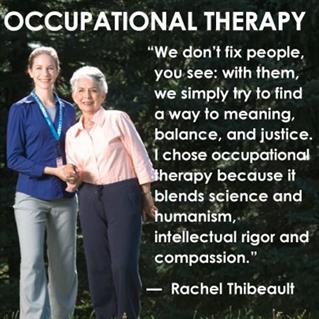 Occupational therapy can change people’s lives. During April’s Occupational Therapy Month, take a minute to learn more about the benefits of occupational therapy for people who need care and their caregivers.
Occupational therapy can change people’s lives. During April’s Occupational Therapy Month, take a minute to learn more about the benefits of occupational therapy for people who need care and their caregivers.
“People think occupational therapy is the same as physical therapy, but there is so much more to occupational therapy,” said Jillian Guilmette at Fox Rehab. “We do the dressing, bathing, the cooking, the community outing, a driving evaluation—there are infinite possibilities.”
Occupational therapists assist people of all ages who have a mental or physical illness with rehabilitation through the activities of daily living. The American Occupational Therapy Association describes an occupational therapist as someone who “helps people across the lifespan participate in the things they want and need to do through the therapeutic use of everyday activities.” Furthermore, the evaluations, interventions, and outcomes of occupational therapy can “help a child with disabilities participate in school and in social situations, assist a person recovering from injuries to regain skills, aid an older adult stay as independent as possible, and offer the specialized support to people of all ages and in all circumstances.”
Caregiving and Occupational Therapy
Much of the work of occupational therapists is also beneficial to caregivers. “We do a lot of education for caregivers,” said Ms. Guilmette. “If someone is only getting one hour of occupational therapy per week, that is not beneficial. But if we can train their caregiver to do the exercises with that person, they can get more out of it.”
By helping an individual regain some of their independence, occupational therapy can also relieve some of the burden on the caregiver. We work on strengthening and balance and safety,” she explained. “These are all important for dressing and bathing. We want to get them as independent and as safe as possible.”
Ms. Guilmette said that occupational therapists can teach caregivers safe body mechanics so that they do not injure themselves trying to lift or move a loved one.
“There are ways the therapist can help the patients to relieve some of the stress on the family,” she said.
Changing Lives
One of Ms. Guilmette’s most rewarding experiences as an occupational therapist was helping a woman not only regain an important physical skill, but helping to eliminate her depression. “I had a woman who had been told she would never walk again and had been moved from her home to assisted living” she said. “When I came in she was very depressed. She had given up.”
Ms. Guilmette worked with the woman, 72, addressed some swelling in her legs and one day—after 16 months of regular therapy—the woman decided to try standing up independently. “That day she walked sixty-five feet to the dining room and everybody there started clapping when she walked in,” she recalled. “It was an amazing experience to see her face light up when she walked into that dining room. She has never used a wheelchair again.”
While being able to walk is a big milestone, Ms. Guilmette said that even seemingly small things can represent reaching a goal for people who need occupational therapy. “Look at the person and the goal and their diagnosis,” she said.





